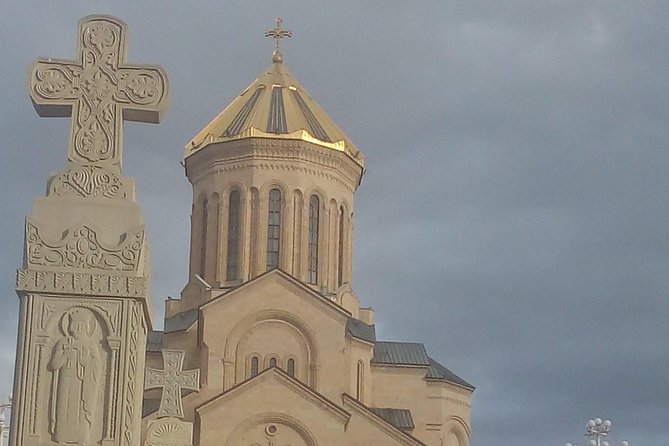Tbilisi Trip Overview
Private full day tour to Uplistsikhe includes visiting 11th century Georgian Orthodox cross-in-square cathedral of Samtavisi with unique ornaments, museum and house of soviet leader Joseph Stalin, Ateni Sioni which is 7th century Georgian Orthodox “Jvari-type” cross-domed tetra conch church and Uplistsikhe, an ancient rock-hewn town and one of the oldest urban settlements (3rd millennium BC). Private tour to Uplistsikhe is ideal for people who are interested in medieval monasteries, birthplace of Soviet politician and pagan and Christian architecture in an ancient cave town of Georgia. Total drive 215 km (135 miles).
Additional Info
Duration: 9 hours
Starts: Tbilisi, Georgia
Trip Category: Cultural & Theme Tours >> Cultural Tours
Explore Tbilisi Promoted Experiences
What to Expect When Visiting Tbilisi, Georgia, Georgia
Private full day tour to Uplistsikhe includes visiting 11th century Georgian Orthodox cross-in-square cathedral of Samtavisi with unique ornaments, museum and house of soviet leader Joseph Stalin, Ateni Sioni which is 7th century Georgian Orthodox “Jvari-type” cross-domed tetra conch church and Uplistsikhe, an ancient rock-hewn town and one of the oldest urban settlements (3rd millennium BC). Private tour to Uplistsikhe is ideal for people who are interested in medieval monasteries, birthplace of Soviet politician and pagan and Christian architecture in an ancient cave town of Georgia. Total drive 215 km (135 miles).
Stop At: Samtavisi Cathedral, 11km of the town of Kaspi, Kaspi Georgia
Samtavisi is an 11th century Georgian Orthodox cross-in-square cathedral built in 1030 by a local bishop and architect Hilarion, the son of Vache Kanchaeli, who also built a wine cellar in 1050. The first temple was built by Vakhtang Gorgasali in 472 and was later rebuilt in the 10th century, but neither has survived. Assyrian missionary Isidore came in the monastery in 6th century. Earthquakes caused the dome, western wall and the pillars to collapse. The inscription on the western façade above the window, says “The secondary builder of the temple was the daughter of king and the wife of Amilakhvari Gaiane”. The cathedral was first partially reconstructed in the 15th-16th centuries
Duration: 40 minutes
Stop At: Graklianis Gora, Samtavisi – Lower Chala Rd, Igoeti, Georgia
Grakliani Hill is an archaeological excavation site showing evidence of human presence possibly going back 300,000 years. The site was discovered in 2007, during work to widen the Tbilisi-Senaki-Leselidze highway. The site contains a temple to a fertility goddess from the seventh century BCE, a pit-type burial cemetery from the early Bronze Age, and the remains of a building from around 450-350 BCE; the building consists of three rooms with three storage rooms. The site had been occupied between the Chalcolithic and the Late Hellenistic periods. The excavation of layers yielded artifacts including children’s toys, weapons, icons, and pharmacological devices. Among the most significant artifacts may be a fourth century BCE printing device. These were extremely rare seals used to stamp judicial documents; supposedly they originated from Uruk in Mesopotamia. Another notable find is that of a large and decorated ritual oven, an unprecedented find in archaeology.
Duration: 30 minutes
Stop At: Stalin Museum, 32 Stalin Avenue Stalin Park, Gori 1400 Georgia
Joseph Stalin Museum (1957) is dedicated to the life of Joseph Stalin, Soviet leader born in Gori. Museum has a small wooden hut, in which Stalin was born in 1878 and spent his first four years. Stalin’s father Bessarion Jughashvili, a local shoemaker, rented a room here and had a workshop in the basement.The main building was opened in 1951 as a museum of socialism, but became a memorial of Stalin, who died in 1953. The display concludes with a death mask of Stalin taken shortly after his death. Museum has Stalin’s personal armored railway carriage that weighs 83 tons. It was used by Stalin from 1941 when he attended the Yalta and the Tehran Conferences. It was sent to the museum in 1985.
Duration: 1 hour 30 minutes
Stop At: Ateni Sioni Church, Khidistavi-Ateni-Boshuri, Georgia
Ateni Sioni (Church of the Assumption of the Virgin Mary) is 7th century Georgian Orthodox “Jvari-type” cross-domed tetra conch church that stands on a 5th century classical basilica. The name “Sioni” derives from Mount Zion at Jerusalem. Ateni Sioni has entrance from the north and its dome base rests on three tromps, transitioned to the four apses of the tetra conch. The lower tromp is eight-faceted, the middle sixteen and the upper thirty-two-faceted. Original reliefs of the western façade depict deer hunting scene. Artist placed an empty ashlar to show distance of arrow flight. Another relief of two deer drinking from a rounded pool is on the northern entrance. The relief symbolizes believers drinking from the same source of faith.
Duration: 40 minutes
Stop At: Uplistsiche Cave Town, Kvakhvreli 15 km Eastwards to Town Gori, Gori 1423 Georgia
Uplistsikhe (“the lord’s fortress”) is an ancient rock-hewn town in eastern Georgia in Shida Kartli. Built on a high rocky left bank of the Mtkvari River. Uplistsikhe is one of the oldest urban settlements in Georgia (people lived here in 3rd millennium BC). It was founded by mythical Uplos, son of Mtskhetos, and grandson of Kartlos, ancestor of the Georgians. The complex is divided into three parts: south (lower), middle (central) and north (upper) covering 8 hectares. The rock-cut structures include houses, a large hall, called Tamaris Darbazi, pagan places of sacrifice, bakery, prison, cellars, and even an amphitheater, all connected by footways and tunnels.
Duration: 1 hour 30 minutes






